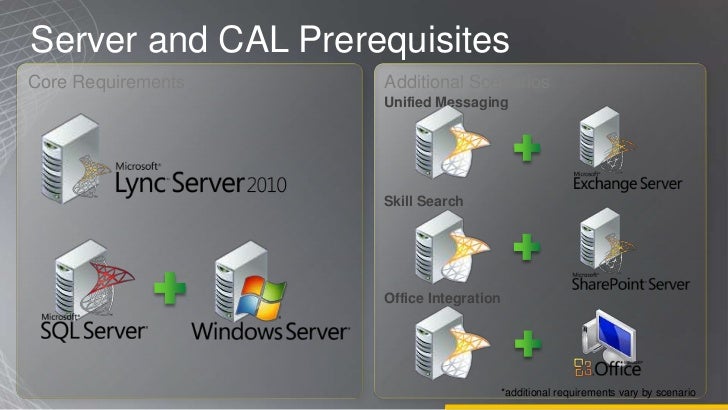
Not entire feature areas such as video or collaboration, but levels of features within those areas. The different CAL types-enterprise and standard-enable different features. Client Access Licenses and licenses for the clients themselves are two different things-totally separate from each other-and should not be confused with one another. The key difference between Standard and Enterprise servers originally pertained to high availability, but now with HA for the Standard server option, the primary difference involves capacity. The server type (Standard and Enterprise) has nothing to do with the Standard and Enterprise CAL types. Once the volume licensing is sorted out, then comes the engineering. Additionally, there are different programs for non-profits, government, education, and multi-national organizations.
Microsoft lync licensing software#
The programs may or may not include software assurance and support, may or may not include actual licenses (perpetual) as opposed to a rental (subscription). There are numerous such programs and they vary tremendously. Most implementations will also (optionally) integrate with Exchange and SharePoint, but neither integrations are required-thus they are not considered part of "Lync licensing."Īs Lync is targeted to larger organizations, the first step in evaluating licensing is for you to research whether your organization already has a Microsoft volume licensing arrangement in place.
Microsoft lync licensing windows#
Desktops are generally part of a Windows infrastructure with Active Directory. IP phones can be licensed to users or as devices. In addition to Lync Server, there is also a Lync client for the desktop. The number of servers and the roles associated with each server vary by implementation requirements and can be complex. The next level down: there are two kinds of servers (Standard and Enterprise), three kinds of CALs (Standard, Enterprise, and Plus), and various connectors that are charged either one time only, or monthly. Starting with the server, there are three types of Lync server 2010 licenses: Lync licensing is conceptually easy, but there is no shortage of rabbit holes. These documents address most, but not all questions. These documents address the basic structure of the programs, but assume a familiarity with Microsoft licensing. Microsoft publishes two critical guides to understanding Lync licensing: Microsoft Lync Server 2010 Licensing Guide and Microsoft Volume Licensing Reference Guide. This can reduce the quotes to only design, implementation, and add-on components. Even worse, the software, or major components of it, may already be in place through a volume licensing program. With Lync, the assumptions of what's in place are broader, particularly around Microsoft products and components (Active Directory, Exchange, SharePoint, Office) and Microsoft doesn't provide the hardware-thus Lync quotes tend to be Lync-specific licensing only.

It is common for quotes not to include LAN switches, power considerations, or HVAC, as those items are typically already in place.

For example, a typical UC VoIP quote covers licensing, dedicated servers, required hardware, and related applications such as unified messaging or presence. The major difference in approach relates to dedicated versus shared infrastructure.

Some accuse Microsoft of purposely making it overly complex and difficult, but in their defense they are licensing Lync the same as their other enterprise offerings. Simply put, the product approaches communications from a different perspective and that includes licensing. Microsoft Lync shook up the unified communications market in numerous ways.


 0 kommentar(er)
0 kommentar(er)
